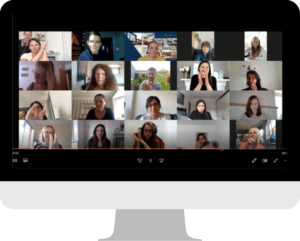 Top 4 tips to combat Zoom fatigue
Top 4 tips to combat Zoom fatigue
Communication Professor Jeremy Bailenson, from the Stanford Virtual Human Interaction Lab (VHIL), has written the first peer-reviewed article that systematically deconstructs Zoom fatigue from a psychological perspective.
(And it fully backs up everything I have been saying on the subject for the last year, so I love him for that!)
 It’s unnatural!
It’s unnatural!
Both the amount of eye contact we engage in on video chats, as well as the size of faces on screens is not a natural state for our brains. Bailenson said. “[In real life] when you’re standing up and everybody’s staring at you, that’s a stressful experience.”
Faces can appear too large for your brain “…you’re seeing faces at a size which simulates a personal space that you normally experience when you’re with somebody intimately,” Bailenson said. “Our brains interpret that as intensity that could lead to either mating or to conflict.” (Hmmmm – uncomfortable!)
TOP TIP 1: Come out of full-screen mode and reduce the size of the Zoom window to minimise face size, and use an external keyboard to allow an increase in the personal space bubble between you and the infamous Zoom grid.
 It’s tiring to constantly be watching yourself
It’s tiring to constantly be watching yourself
In real life, if you were seeing yourself in a mirror while you were; talking to people, making decisions, giving feedback, getting feedback etc etc – that would be crazy making.
Many of us now watch ourselves in real time for many hours every day. It’s tiring!
TOP TIP 2: Use the “hide self-view” option in the latest update – if you haven’t updated lately – do it now!
 Being on video reduces our mobility
Being on video reduces our mobility
We humans like to walk around and move when we communicate, and in person and on audio we can. But on video cameras have a set field of view, meaning you generally stay in the same fixed position. Moving allows our brain to perform better.
TOP TIP 3: Do whatever you can to pace and doodle in virtual meetings just like we do in real ones! And of course, turning your video off every now and then gives you a brief rest.
 The cognitive load is higher on video
The cognitive load is higher on video
Bailenson backs up what I say in my video; in regular face-to-face interaction, nonverbal communication is key and on video comms we have to work harder to send and receive signals.
Regular communication is now transformed into something that involves a lot of thought:
- “How is my head is framed in the video?”
- “I need to exaggerate my nods or put your thumbs up to agree”
- “What’s my child doing coming through that door?”
All of these new tasks create a cognitive load that we’ve never had to worry about before!
TOP TIP 4: Give yourself an “audio only” break. But, don’t just turn off the camera. Also turn your body away from the screen. Breaking the constant visual cognition for a few minutes will let your mind rest.
(Be sure to communicate with those on the call …you wouldn’t just disappear from a real room without an explanation!)
For more, watch my video from the early pandemic days on The Science of Zoom Fatigue.





